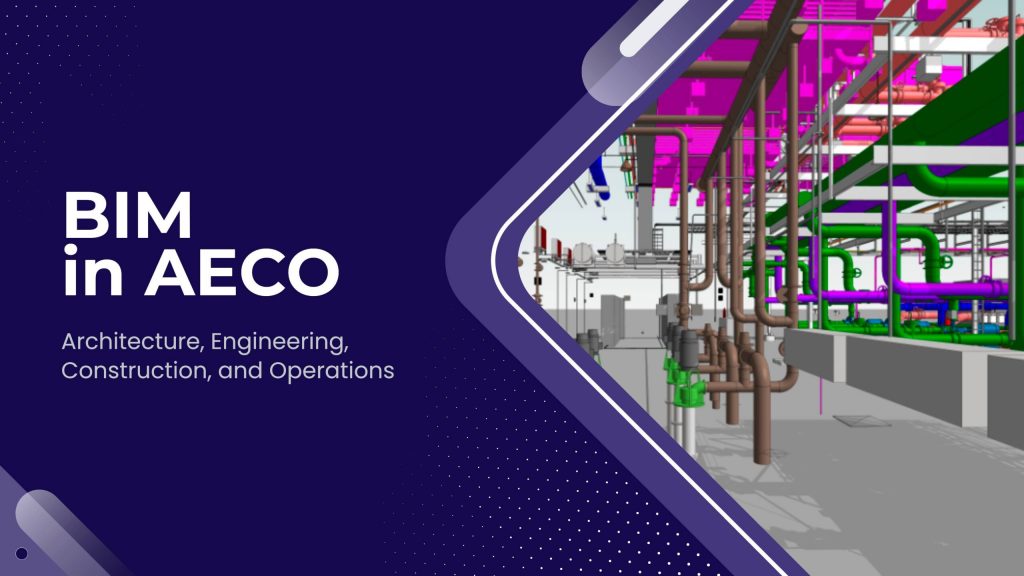AECO? Architecture, Engineering, Construction, and Operations are the acronyms of AECO, a sector in which the BIM collaborative work methodology is entering strongly.
The BIM methodology has revolutionized the AECO sector. More and more companies (developers, architecture studios, engineering firms, construction companies, etc.) are turning to it and looking for experts in the field. Therefore, today we are going to write about it, and in addition to telling you what the AECO sector is, we are going to explain its relationship with BIM, and specifically, the implementation process BIM in this sector, in its managers, as well as in the tasks that they have to develop.
Building Information Modeling is a collaborative work methodology for the conception and management of building and civil works projects. BIM centralizes all the information of a project (geometric or 3D, times or 4D, costs or 5D, environmental or 6D, and maintenance or 7D) in a BIM model developed by all its agents.
And since there are different ways and processes to carry out a BIM implementation in companies in the AECO sector, we are going to show you our approach:
What is AECO?
AECO is the acronym for Architecture, Engineering, Construction, and Operations. Therefore, when we talk about the AECO sector, we include companies related to the operations and maintenance of buildings and infrastructures, as well as their professionals: Architects, engineers, draftsmen, surveyors, manufacturers, etc.
AECO and BIM sectors
The AECO sector is no stranger to the digital revolution and has to adapt to the new challenges that this entails. Technological and professional changes in which collaborative work is increasingly important.
It is in this context that the need to implement BIM in a construction process becomes more evident. Success is the result of architecture, engineering, construction, or operations projects depending on the proper implementation of this work methodology by professionals in the AECO sector.
“AE” of AECO: Architecture and Engineering
The process of implementing the BIM methodology in architecture or engineering firms (“AE” of AECO) is similar to that of a developer, although usually on a different scale.
We will show you how we usually approach it from the BIM Consulting area of BIM space:
PHASE 00
Analysis: First, we analyze your work processes. For it:
We develop a Responsibilities Matrix where we break down its main process, the writing of Execution Projects and the Direction of the Work, in the tasks necessary for its development, indicating who executes each of these tasks, who is responsible, and who is owed.
According to the Responsibilities Matrix, we describe the current status.
Once the current status has been described, we specify the impact of the implementation of the BIM methodology in their work processes.
BIM implementation plan: Once we know their way of working, we develop an implementation plan so that they can develop their projects under the BIM methodology.
We define the BIM objectives: BIM roles and teams, tasks and responsibilities; dates, milestones, meeting scheduling, quality controls; coordination conditions and times of information exchanges between agents; norms, BIM standards, legislative and security considerations, protocols; software, hardware and server to use; and so on.
We estimate the necessary investments: equipment, licenses, etc.
We develop a schedule for implementation.
BIM protocol: We develop a procedure to standardize and unify the way in which information is processed and shared.
Strategy:
- Reference documents.
- Work team.
- Objectives and BIM Uses.
- LOD specification.
- Hardware and software platforms.
- CDE, or Common Data Environment.
- Communication strategy.
- Federated strategy.
- Modeling strategy.
- Classification strategy.
- Naming convention.
Methodology:
- Project template.
- Set phrase.
- Units.
- Coordinate system.
- Levels and grids.
- Summary of methodology and procedures.
PHASE 01
Phase 01 is developed in parallel to Phase 00. In it, we train the team according to the conclusions derived from the Analysis and BIM implementation plan.
PHASE 02
In Phase 02 the BIM methodology is implemented in the project. For it:
- We write the BIM or BEP Execution Plan.
- We coordinate the monitoring of the contract in the Drafting and Execution phases of the work.
“C” of AECO: Construction
Once the BIM implementation process has been explained by the first agents of the AECO sector involved, We give way to the construction companies (“C” for AECO), in this case focusing on their managers and tasks to be carried out:
Heads and Technicians of the Studies and Offers Department:
- Interpret a Bidding Document.
- Understand how information is structured in a 3D BIM model.
- Extract from it a work measurement.
- Plan work (also based on a model).
Technical Directors and Technical Managers of the Works Department:
- Manage a BIM project.
- Plan the work.
- Measure and budget for the work.
- Manage assets.
Technical and construction staff of the Works Department:
- Analyze the project and its feasibility.
- Plan the organization of the work and each of its tasks and jobs to be performed.
- Propose the most suitable procedures, techniques, and means.
- Control costs, and construction deadlines.
“O” of AECO: Operations
To finish understanding the BIM implementation process in the AECO sector, it is important to know the figure of the Facility Manager and understand how the BIM methodology has revolutionized Computer-Aided Maintenance Management (CMMS).
CMMS? It is Computer-Aided Maintenance Management, a software tool that helps in the management of the maintenance services of a company. Basically, it is a database that contains information about the company and its maintenance operations. This information helps all maintenance tasks be carried out more safely and efficiently. It is also used as a management tool for decision-making.
This is where the figure of BIM Facility Management was born. The person who ensures and manages the best performance of the properties and their associated services through the integration of people, spaces, processes, and the technologies of the properties. Among the main tasks we highlight:
- Manage projects, documents, and communities.
- Ensure the functionality and operation of the building environment.
- Manage work orders for preventive maintenance -programmed-, corrective, etc.
- Contract the products and services related to the proper functioning of the Assets, their conservation, and maintenance.
- Turn the AIM information model (information model used to manage, maintain and operate property or infrastructure) into a CMMS solution that allows working in a BIM environment.
With these regulations in force, it is normal for professionals in the AECO sector to think about BIM.



